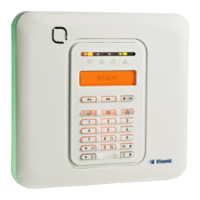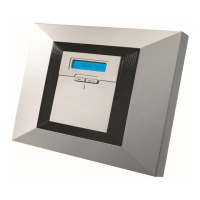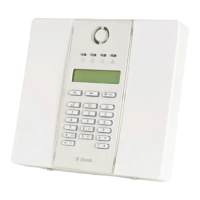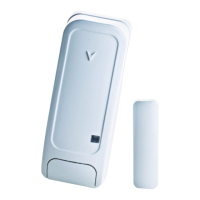APPENDIX F. Glossary
78 D-303222 PowerMaster-10/30 G2 Installer's Guide
Disarming: The opposite of arming - an action that restores the control panel to the normal standby state. In this state,
only fire and 24-hour zones will sound an alarm if violated, but a “panic alarm” may also be initiated.
Disturbed Zone: A zone in a state of alarm (this may be caused by an open window or door or by motion in the field of
view of a motion detector). A disturbed zone is considered “not secured”.
Forced Arming: When any one of the system zones is disturbed (open), the alarm system cannot be armed. One way
to solve this problem is to find and eliminate the cause for zone disturbance (closing doors and windows). Another way
to deal with this is to impose forced arming - automatic de-activation of zones that are still disturbed upon termination
of the exit delay. Bypassed zones will not be protected throughout the arming period. Even if restored to normal
(closed), bypassed zones will remain unprotected until the system is disarmed.
Permission to “force arm” is given or denied by the installer while programming the system.
HOME: This type of arming is used when people are present within the protected site. A classic example is night-time
at home, when the family is about to retire to bed. With HOME arming, perimeter zones are protected but interior zones
are not. Consequently, motion within interior zones will be ignored by the control panel, but disturbance of a perimeter
zone will cause an alarm.
Instant: You can arm the system AWAY-INSTANT or HOME-INSTANT, thereby canceling the entry delay for all delay
zones for the duration of one arming period.
For example, you may arm the control panel in the HOME-INSTANT mode and remain within the protected area. Only
perimeter protection is active, and if you do not expect somebody to drop in while the system is armed, alarm upon
entry via the main door is an advantage.
To disarm the system without causing an alarm, use your control keypad (which is normally accessible without
disturbing a perimeter zone) or use a keyfob transmitter.
Latchkey: The Latchkey mode is a special arming mode in which designated "latchkey users" will trigger a "latchkey
message" to be sent to a telephone when they disarm the system.
For example, if a parent wants to be sure that their child has returned from school and disarmed the system. Latchkey
arming is only possible when the system is armed in the AWAY mode.
Location: Assigning a named location to a device (for example, Garage, Front Door etc.)
Magnetic Contact Detector, Wireless: A Magnet- controlled switch and a wireless PowerG transmitter in a shared
housing. The detector is mounted on doors and windows to detect changes in state (from closed to open and vice
versa). Upon sensing that a door or window is open, the detector transmits its unique identification code accompanied
by an “alarm” signal and various other status signals to the control panel.
The control panel, if not armed at that time, will consider the alarm system as “not ready for arming” until it receives a
“restored” signal from the same detector.
Motion Detector, Wireless: A passive Infrared motion sensor and a wireless PowerG transmitter in a shared housing.
Upon sensing motion, the detector transmits its unique identification code, accompanied by an alarm signal and various
other status signals to the control panel. After transmission, it stands by to sense further motion.
Non-Alarm Zone: Your installer can designate a zone for roles other than alarm. For instance, a motion detector
installed in a dark stairway may be used to switch on lights automatically when someone crosses the dark area.
Another example is a wireless transmitter linked to a zone that controls a gate opening mechanism.
Quick Arming: Arming without a user code. The control panel does not request your user code when you press one of the
arming buttons. Permission to use this arming method is given or denied by the installer while programming the system.
Remote Responder: A responder can be either a professional service provider to which the home or business owner
subscribes (a Monitoring Station) or a family relation/friend who agrees to look after the protected site during absence
of its occupants. The control panel reports events by telephone to both kinds of responders.
Restore: When a detector reverts from the state of alarm to the normal standby state, it is said to have been “restored”.
A motion detector restores automatically after detection of movement, and becomes ready to detect again. This kind of
“restore” is not reported to the remote responders.
A magnetic contact detector restores only upon closure of the protected door or window. This kind of “restore” is
reported to the remote responders.
Sensor: The sensing element: pyroelectric sensor, photo-diode, microphone, smoke optical sensor etc.
Signal Strength: The quality link communication between the system components and the control panel.
Smoke Detector, Wireless: A regular smoke detector and a wireless PowerG transmitter in a shared housing. Upon
detection of smoke, the detector transmits its unique identification code accompanied by an alarm signal and various
status signals to the control panel. Since the smoke detector is linked to a special fire zone, a fire alarm is initiated.
State: AWAY, HOME, AWAY-INSTANT, HOME-INSTANT, LATCHKEY, FORCED, BYPASS.
Status: AC fail, low battery, trouble, etc.
User Codes: The PowerMaster is designed to obey your commands, provided that they are preceded by a valid
security access code.
Unauthorized people do not know this code, so any attempt on their part to disarm or defeat the system is bound to fail.
Some operations, however, can be carried out without a user code as they do not degrade the security level of the
alarm system.
Zone: A zone is an area within the protected site under supervision of a specific detector. During programming, the
installer allows the control panel to learn the detector’s identity code and links it to the desired zone. Since the zone is
distinguished by number and name, the control panel can report the zone status to the user and register in its memory
all the events reported by the zone detector. Instant and delay zones are “on watch” only when the control panel is
armed, and other (24-hour) zones are “on watch” regardless of whether the system is armed or not.
Zone Type: The zone type determines how the system handles alarms and other signals sent from the device.

